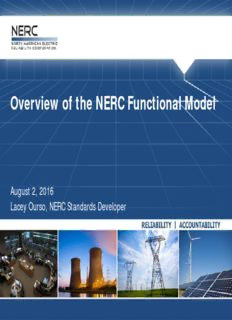
Overview of the NERC Functional Model PDF
Preview Overview of the NERC Functional Model
Overview of the NERC Functional Model August 2, 2016 Lacey Ourso, NERC Standards Developer Agenda • Background information regarding the Functional Model (FM) and Functional Model Advisory Group (FMAG) • 2016 FMAG project • Questions 2 RELIABILITY | ACCOUNTABILITY Background Information • Purpose of the Functional Model (FM): Guideline that identifies the functions that must be performed to ensure that the Bulk Power System is planned and operated in a reliable manner. Describes the specific tasks that are required to perform the reliability functions, and the relationships between the functional entities that perform those tasks • Functional Model Technical Document (FMTD): Companion document that elaborates on various functions, tasks and relationships between functional entities. 3 RELIABILITY | ACCOUNTABILITY Brief History of the FM • 1999: NERC Operating Committee formed the “Control Area Task Force” for the purpose of identifying tasks required for maintaining reliability. • February 2002: Version 1 of the FM approved by the NERC Board of Trustees (BOT). This version focused on operation-centric tasks. • February 2004: Version 2 of the FM approved by the BOT. Revisions focused on adding planning-related functions, which were not included in Version 1. • February 2007: Version 3 of the FM approved by the BOT. Revisions focused on addressing alignment issues as a result of NERC Reliability Standards becoming mandatory and enforceable. • August 2008: Version 4 of the FM approved by the BOT. • May 2010: Version 5 of the FM approved by the BOT. 4 RELIABILITY | ACCOUNTABILITY Functional Model Advisory Group • Purpose of the Functional Model Advisory Group (FMAG): 1. Maintain the FM (and FMTD) to ensure the model correctly reflects the industry today, and 2. Evaluate and incorporate new and emergent reliability- related tasks • FMAG reports to the Standards Committee (SC) and “advises and consults” with the Planning Committee (PC), Operating Committee (OC), and Critical Infrastructure Protection Committee (CIPC) 5 RELIABILITY | ACCOUNTABILITY Revisions to the FM and FMTD • FMAG to maintain FM to ensure it accurately reflects the industry today and incorporates any new or emergent reliability-related tasks. Review may be initiated by the Standards Committee, FMAG or based on any identified reliability-related need, such as: Standing/technical committees may identify an issue or area for consideration, and request the FMAG assess whether appropriate to add a new (or revise an existing) function, task or relationship Industry request • Revision process: FMAG to work with standing committees (Operating Committee, Planning Committee, Critical Infrastructure Protection Committee) to obtain “endorsement” of technical content Proposed revisions posted for industry comment period SC ultimately endorses revisions to the FM and FMTD, before the documents are posted on the NERC website 6 RELIABILITY | ACCOUNTABILITY FMAG Roster Name Organization Name Organization Jim Cyrulewski JDRJC Ben Li Ben Li Associates (co-chair) Associates, LLC Linn Oelker LG&E and KU Jerry Rust Northwest Power Services Company (co-chair) Pool Dennis Chastain Tennessee Valley Steven Rueckert WECC Authority Tom Siegrist Stone, Mattheis Al Dicaprio PJM Mike Steckelberg Great River Interconnection Energy Pete Heidrich FRCC Mike Yealland Independent Tony Jankowski We Energies Electricity System Operator (retired) Lorissa Jones Bonneville Power Administration Joseph A. Wilson Tacoma Power 7 RELIABILITY | ACCOUNTABILITY 2016 FMAG project • Version 5 (current version) of the FM and FMTD developed in 2009 and approved by the NERC Board of Trustees in 2010. • Focus of 2016 FMAG project: Review the model to ensure it correctly reflects the industry today Identify changes needed to the model as a result of new and emergent reliability-related issues Identify changes needed as a result of recent NERC initiatives (i.e., Risk-Based Registration initiative) and standard development projects (i.e., Alignment of Terms) 8 RELIABILITY | ACCOUNTABILITY Project Timeline • January 19-20: FMAG meeting to identify areas for focus • March 8: Inform standing committees (OC, PC, CIPC) of work underway, and obtain initial feedback (specific to area of expertise) • March 17-18: FMAG meeting to develop revisions to the FM • April 13-15: FMAG meeting to develop revisions to FM and FMTD • June 7-8: Present proposed revisions to committee members (OC, PC, CIPC) for the purpose of obtaining feedback • June 15-17: FMAG meeting to review and incorporate feedback from committees (OC, PC, and CIPC), and revise FM and FMTD 9 RELIABILITY | ACCOUNTABILITY Project Timeline (cont) • July 20: Obtain SC approval to post proposed revisions to FM and FMTD for informal industry comment period • July 22 – September 7: Post proposed revisions for 45-day industry comment period • September/October: FMAG meeting to review industry comments and revise FM and FMTD based on industry feedback • December: Present final revisions to the FM and FMTD to standing committees (OC, PC, and CIPC) for endorsement 10 RELIABILITY | ACCOUNTABILITY
Description: